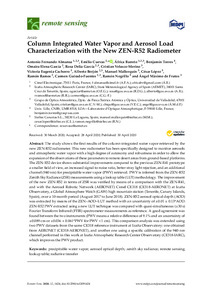Por favor, use este identificador para citar o enlazar este ítem:
http://hdl.handle.net/20.500.11765/11783
Column integrated water vapor and aerosol load characterization with the new ZEN-R52 radiometer
| Título : | Column integrated water vapor and aerosol load characterization with the new ZEN-R52 radiometer |
| Autor : | Almansa Rodríguez, Antonio Fernando









 ; Velasco Merino, Cristian; Cachorro, Victoria E.; Berjón, Alberto
; Velasco Merino, Cristian; Cachorro, Victoria E.; Berjón, Alberto

|
| Palabras clave : | Precipitable water vapor; Aerosol optical depth; Zenith sky radiance; Remote sensing; Lookup table; Radiative transfer |
| Fecha de publicación : | 2020 |
| Editor: | Multidisciplinary Digital Publishing Institute |
| Citación : | Remote Sensing. 2020, 12(9), 1424 |
| Versión del editor: | https://dx.doi.org/10.3390/rs12091424 |
| Resumen : | The study shows the first results of the column-integrated water vapor retrieved by the new ZEN-R52 radiometer. This new radiometer has been specifically designed to monitor aerosols and atmospheric water vapor with a high degree of autonomy and robustness in order to allow the expansion of the observations of these parameters to remote desert areas from ground-based platforms. The ZEN-R52 device shows substantial improvements compared to the previous ZEN-R41 prototype: a smaller field of view, an increased signal-to-noise ratio, better stray light rejection, and an additional channel (940 nm) for precipitable water vapor (PWV) retrieval. PWV is inferred from the ZEN-R52 Zenith Sky Radiance (ZSR) measurements using a lookup table (LUT) methodology. The improvement of the new ZEN-R52 in terms of ZSR was verified by means of a comparison with the ZEN-R41, and with the Aerosol Robotic Network (AERONET) Cimel CE318 (CE318-AERONET) at Izaña Observatory, a Global Atmosphere Watch (GAW) high mountain station (Tenerife, Canary Islands, Spain), over a 10-month period (August 2017 to June 2018). ZEN-R52 aerosol optical depth (AOD) was extracted by means of the ZEN–AOD–LUT method with an uncertainty of ±0.01 ± 0.13*AOD. ZEN-R52 PWV extracted using a new LUT technique was compared with quasi-simultaneous (±30 s) Fourier Transform Infrared (FTIR) spectrometer measurements as reference. A good agreement was found between the two instruments (PWV means a relative difference of 9.1% and an uncertainty of ±0.089 cm or ±0.036 + 0.061*PWV for PWV <1 cm). This comparison analysis was extended using two PWV datasets from the same CE318 reference instrument at Izaña Observatory: one obtained from AERONET (CE318-AERONET), and another one using a specific calibration of the 940-nm channel performed in this work at Izaña Atmospheric Research Center Observatory (CE318-IARC), which improves the PWV product. |
| Patrocinador: | This work has been developed within the framework of the activities of the World Meteorological Organization (WMO) Commission for Instruments and Methods of Observations (CIMO) Izaña Testbed for Aerosols andWater Vapor Remote Sensing Instruments. AERONET sun photometers at Izaña were calibrated within theAERONETEurope TNA, supported by the European Community Research Infrastructure Action under the FP7 ACTRIS grant, agreement no. 262254. The authors are grateful to the Spanish Ministry of Science, Innovation and Universities for its support through the ePOLAAR project (RTI2018-097864-B-I00). |
| URI : | http://hdl.handle.net/20.500.11765/11783 |
| ISSN : | 2072-4292 |
| Colecciones: | Artículos científicos 2019-2022 |
Ficheros en este ítem:
| Fichero | Descripción | Tamaño | Formato | ||
|---|---|---|---|---|---|
| Column_Integrated_Wat... | 2,72 MB | Adobe PDF |  Visualizar/Abrir |
Los ítems de Arcimis están protegidos por una Licencia Creative Commons, salvo que se indique lo contrario.





